Improving the Power Supply Performance in Rural Smart Grids with Photovoltaic DG by Optimizing Fuse Selection
Abstract
1. Introduction
2. Materials and Methods
2.1. Coordination between Protection Fuses
- Minimum melting curve (as the lower boundary), which detects the minimum overcurrent causing the link to start melting.
- Full opening curve (as the upper boundary), indicating the complete blowing of the fuse and the circuit opening.
- For faults in the main feeder, the F2 fuse will not detect any fault current, with F1 fuse being the one that will act as main protection.
- For faults in the branch line, F2 will act as the main protection and F1 as a backup protection.
2.2. Modeling the Performance of Fuses
2.3. Distrtibution Network
- Zone 1, connected to the substation through fuse F1
- Zone 2, connected to the substation through fuse F3
- Zone 3, connected to the substation through fuses F2 and F5
- Zone 4, connected to the substation through fuses F2 and F8
- the nominal fuse current needs to be above the maximum expected generator load current with a sufficient margin (125% load)
- the fuse should not trip with generator connection currents [34]
- IF1 ≥ 1.25 ILOAD 634
- IF2 ≥ 1.25 (ILOAD 611 + ILOAD 652 + ILOAD 692 + ILOAD 625 + ILOAD 671) > IF5
- IF3 ≥ 1.25 (ILOAD 645 + ILOAD 646) > IF4
- IF4 ≥ 1.25 ILOAD 646
- IF5 ≥ 1.25 (ILOAD 611 + ILOAD 652) > IF6
- IF6 ≥ 1.25 ILOAD 652
- IF7 ≥ 1.25 ILOAD 611
- IF8 ≥ 1.25 (ILOAD 692 + ILOAD 675) > IF9
- IF9 ≥ 1.25 ILOAD 675
3. Cases Studied and Results
- correct performance, that is, no fuse is tripped, indicated by “OK”, or
- possible incorrect performance, in which some fuses are tripped.
4. Conclusions
- The effect of photovoltaic DG on fuse coordination in a power network similar to the ones present in small rural villages has been checked. The results indicate that an improper coordination of fuses (correctly selected in the case of no DG presence) might be produced.
- A new and easy way to simulate the performance of fuses has been described.
- Thanks to the aforementioned new fuse modeling, criteria to select new fuses in power networks that can ensure a proper coordination between them have been described.
- The present study can be extrapolated to networks with DG consisting of other kinds of sources (different from the photovoltaic ones), as the main control parameter is the current supplied to the network.
Author Contributions
Funding
Institutional Review Board Statement
Informed Consent Statement
Acknowledgments
Conflicts of Interest
References
- Paithankar, Y.G.; Bhide, S.R. Fundamentals of Power System Protection; PHI Learning Pvt. Ltd.: Delhi, India, 2010. [Google Scholar]
- Barrenetxea, A.I. Protecciones de Sistemas de Potencia; Universidad del País Vasco, Servicio Editoria/Euskal Herriko Unibertsitatea, Argitalpen Zerbitzua: Biscay, Spain, 1997. [Google Scholar]
- Dugan, R.C.; McDermott, T.E. Operating conflicts for distributed generation on distribution systems. In Proceedings of the Papers—Rural Electric Power Conference, Little Rock, AR, USA, 29 April–1 May 2001. [Google Scholar]
- Salman, S.K.; Rida, I.M. Investigating the impact of embedded generation on relay settings of utilities’ electrical feeders. IEEE Trans. Power Deliv. 2001, 16, 246–251. [Google Scholar] [CrossRef]
- Bastião, F.; Cruz, P.; Fiteiro, R. Impact of distributed generation on distribution networks. In Proceedings of the 2008 5th International Conference on the European Electricity Market, EEM, Lisboa, Portugal, 28–30 May 2008. [Google Scholar]
- Barker, P.P.; De Mello, R.W. Determining the impact of distributed generation on power systems: Part 1—Radial distribution systems. In Proceedings of the IEEE Power Engineering Society Transmission and Distribution Conference, Seattle, WA, USA, 16–20 July 2000; Volume 3, pp. 1645–1656. [Google Scholar]
- Dadkhah, M.; Fani, B.; Heydarian-Forushani, E.; Mohtaj, M. An off-line algorithm for fuse-recloser coordination in distribution networks with photovoltaic resources. Int. Trans. Electr. Energy Syst. 2020, 30, 1–16. [Google Scholar] [CrossRef]
- Deng, W.; Pei, W.; Qi, Z. Impact and improvement of distributed generation on voltage quality in micro-grid. In Proceedings of the 3rd International Conference on Deregulation and Restructuring and Power Technologies, DRPT 2008, Nanjing, China, 6–9 April 2008; pp. 1737–1741. [Google Scholar]
- Wang, S. Distributed generation and its effect on distribution network system. In Proceedings of the IET Conference Publications, Prague, Czech Republic, 8–11 June 2009. [Google Scholar]
- Naiem, A.F.; Hegazy, Y.; Abdelaziz, A.Y.; Elsharkawy, M.A. A classification technique for recloser-fuse coordination in distribution systems with distributed generation. IEEE Trans. Power Deliv. 2012, 27, 176–185. [Google Scholar] [CrossRef]
- Hadjsaid, N.; Canard, J.; Dumas, F. Dispersed generation impact on distribution networks. IEEE Comput. Appl. Power 1999, 12, 22–28. [Google Scholar] [CrossRef]
- Girgis, A.; Brahma, S. Effect of distributed generation on protective device coordination in distribution system. In Proceedings of the LESCOPE 2001—2001 Large Engineering Systems Conference on Power Engineering: Powering Beyond 2001, Halifax, NS, Canada, 11–13 July 2001; pp. 115–119. [Google Scholar]
- Brahma, S.M.; Girgis, A.A. Development of Adaptive Protection Scheme for Distribution Systems with High Penetration of Distributed Generation. IEEE Trans. Power Deliv. 2004, 19, 56–63. [Google Scholar] [CrossRef]
- Chaitusaney, S.; Yokoyama, A. Prevention of reliability degradation from recloser-fuse miscoordination due to distributed generation. IEEE Trans. Power Deliv. 2008, 23, 2545–2554. [Google Scholar] [CrossRef]
- Boonyapakdee, N.; Konghirun, M.; Sangswang, A. Separated phase-current controls using inverter-based DGs to mitigate effects of fault current contribution from synchronous DGs on recloser-fuse. Appl. Sci. 2019, 9, 4311. [Google Scholar] [CrossRef]
- Razavi, S.E.; Rahimi, E.; Javadi, M.S.; Nezhad, A.E.; Lotfi, M.; Shafie-khah, M.; Catalão, J.P.S. Impact of distributed generation on protection and voltage regulation of distribution systems: A review. Renew. Sustain. Energy Rev. 2019, 105, 157–167. [Google Scholar] [CrossRef]
- Bayati, N.; Baghaee, H.R.; Hajizadeh, A.; Soltani, M. A Fuse Saving Scheme for DC Microgrids with High Penetration of Renewable Energy Resources. IEEE Access 2020, 8, 137407–137417. [Google Scholar] [CrossRef]
- Alam, M.N.; Das, B.; Pant, V. Protection scheme for reconfigurable radial distribution networks in presence of distributed generation. Electr. Power Syst. Res. 2020, 106973. [Google Scholar] [CrossRef]
- Santoso, S.; Short, T.A. Identification of fuse and recloser operations in a radial distribution system. IEEE Trans. Power Deliv. 2007, 22, 2370–2377. [Google Scholar] [CrossRef]
- Yazdanpanahi, H.; Li, Y.W.; Xu, W. A new control strategy to mitigate the impact of inverter-based DGs on protection system. IEEE Trans. Smart Grid 2012, 3, 1427–1436. [Google Scholar] [CrossRef]
- Hussain, B.; Sharkh, S.M.; Hussain, S.; Abusara, M.A. An adaptive relaying scheme for fuse saving in distribution networks with distributed generation. IEEE Trans. Power Deliv. 2013, 28, 669–677. [Google Scholar] [CrossRef]
- Nojavan, M.; Seyedi, H.; Mahari, A.; Zare, K. Optimization of Fuse-Recloser Coordination and Dispersed Generation Capacity in Distribution Systems. Majlesi J. Electr. Eng. 2014, 8, 15–24. [Google Scholar]
- Yousaf, M.; Mahmood, T. Protection coordination for a distribution system in the presence of distributed generation. Turkish J. Electr. Eng. Comput. Sci. 2017, 25, 408–421. [Google Scholar] [CrossRef]
- Plesca, A. Temperature distribution of HBC fuses with asymmetric electric current ratios through fuselinks. Energies 2018, 11, 1990. [Google Scholar] [CrossRef]
- Chaitusaney, S.; Yokoyama, A. Reliability analysis of distribution system with distributed generation considering loss of protection coordination. In Proceedings of the 2006 9th International Conference on Probabilistic Methods Applied to Power Systems, PMAPS, Stockholm, Sweden, 11–15 June 2006. [Google Scholar]
- Braga, G.; Zanin Bertoletti, A.; Peres de Morais, A.; Ghendy Cardoso, J. Curve Fitting Analysis of Expulsion Fuse Links through the Cross-Validation Technique. In Proceedings of the 2018 IEEE PES Transmission & Distribution Conference and Exhibition—Latin America (T&D-LA), Lima, Peru, 18–21 September 2018; pp. 1–5. [Google Scholar]
- Fazanehrafat, A.; Javadian, S.A.M.; Bathaee, S.M.T.; Haghifam, M.R. Maintaining the recloser-fuse coordination in distribution systems in presence of DG by determining DG’s size. In Proceedings of the IET 9th International Conference on Developments in Power Systems Protection (DPSP 2008), Glasgow, UK, 17–20 March 2008; pp. 132–137. [Google Scholar]
- Tang, Y.; Ayyanar, R. Verification of Protective Device Coordination in Distribution Systems with Photovoltaic Generation. In Proceedings of the 2014 IEEE 40th Photovoltaic Specialist Conference (PVSC), Denver, CO, USA, 8–13 June 2014; pp. 2100–2105. [Google Scholar] [CrossRef]
- Abdel-ghany, H.A.; Azmy, A.M.; Elkalashy, N.I.; Rashad, E.M. Optimizing DG penetration in distribution networks concerning protection schemes and technical impact. Electr. Power Syst. Res. 2015, 128, 113–122. [Google Scholar] [CrossRef]
- Conde Enríquez, A.; Vázquez-Martínez, E. Enhanced time overcurrent coordination. Electr. Power Energy Syst. 2006, 76, 457–465. [Google Scholar] [CrossRef]
- Conde Enríquez, A.; Vázquez-Martínez, E.; Altuve-Ferrer, H.J. Time overcurrent adaptive relay. Electr. Power Energy Syst. 2003, 25, 841–847. [Google Scholar] [CrossRef]
- Costa, G.B.; Marchesan, A.C.; Morais, A.P.; Cardoso, G.; Gallas, M. Curve Fitting Analysis of Time-Current Characteristic of Expulsion Fuse Links. In Proceedings of the 2017 IEEE International Conference on Environment and Electrical Engineering and 2017 IEEE Industrial and Commercial Power Systems Europe (EEEIC/I&CPS Europe), Milan, Italy, 6–9 June 2017; pp. 1–6. [Google Scholar]
- Gers, J.M.; Holmes, E.H. Protection of Distribution Networks; The Institution of Electrical Engineers: London, UK, 2004. [Google Scholar]
- Anderson, P. Power System Protection; Wiley: Hoboken, NJ, USA, 1998. [Google Scholar]
- Viawan, F.A.; Karlsson, D.; Sannino, A.; Daalder, J. Protection scheme for meshed distribution systems with high penetration of distributed generation. In Proceedings of the 2006 Power Systems Conference: Advanced Metering, Protection, Control, Communication, and Distributed Resources, Clemson, SC, USA, 14–17 March 2006; pp. 99–104. [Google Scholar]
- UNE-EN 50182:2002/AC:2013: Conductores para Líneas Eléctricas Aéreas. Conductores de Alambres Redondos Cableados en Capas Concéntricas. Available online: https://www.une.org/encuentra-tu-norma/busca-tu-norma/norma/?c=N0051959 (accessed on 24 March 2021).
- Iberdrola MT 2.13.40: Criterios de Selección y Adaptación del Calibre de los Fusibles de MT para Centros de Transformación. 2003. Available online: https://docplayer.es/40982302-Procedimiento-de-seleccion-y-adaptacion-del-calibre-de-los-fusibles-de-mt-para-centros-de-transformacion.html (accessed on 24 March 2021).
- IEC 60783. Application Guide for the Selection of Fuse-Links of High-Voltage Fuses for Transformer Circuit Applications. 1983. Available online: https://standards.globalspec.com/std/113389/IEC%2060787 (accessed on 24 March 2021).
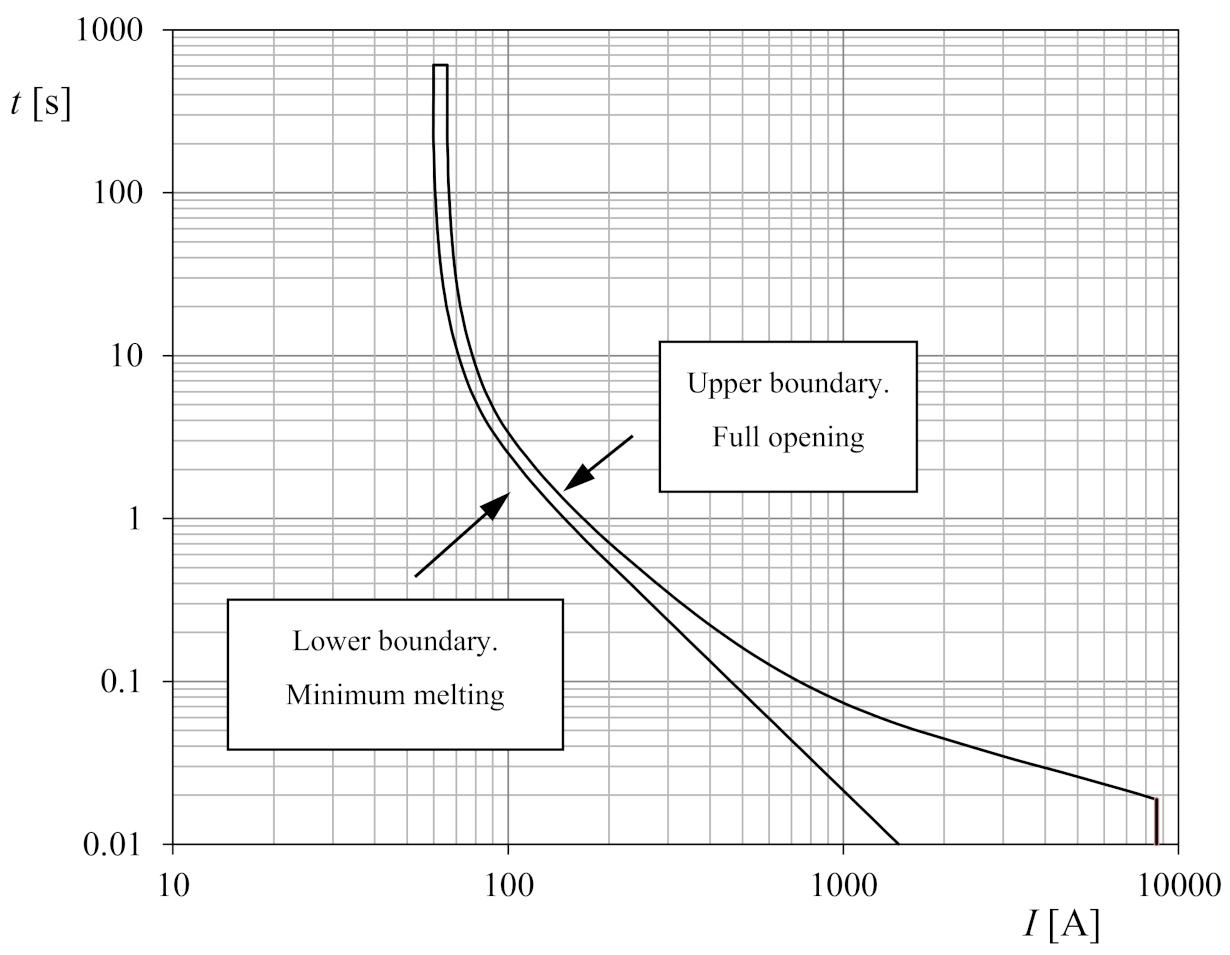

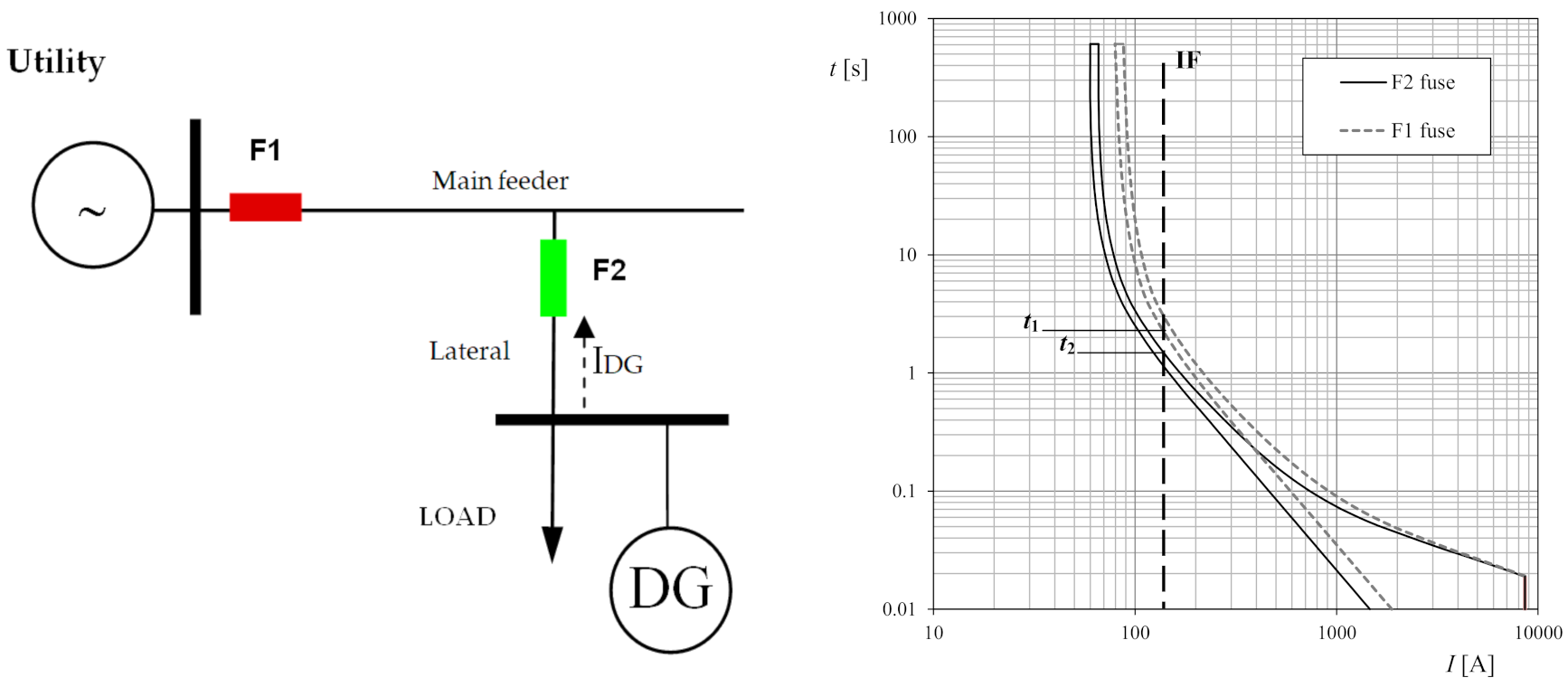
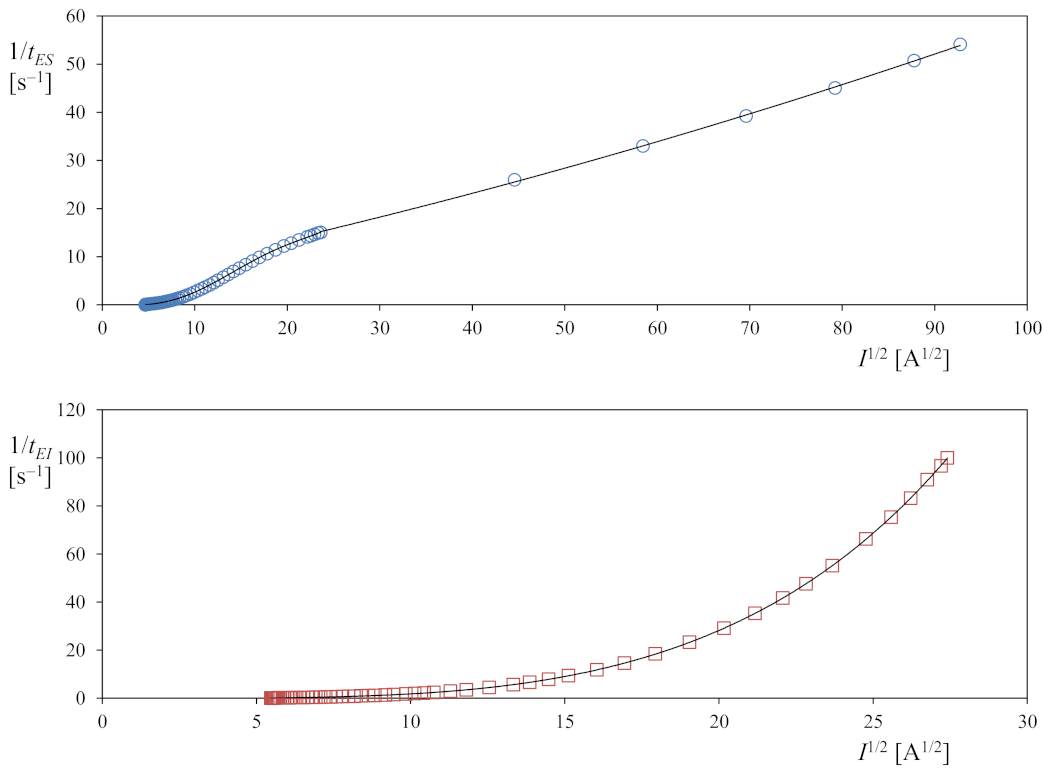
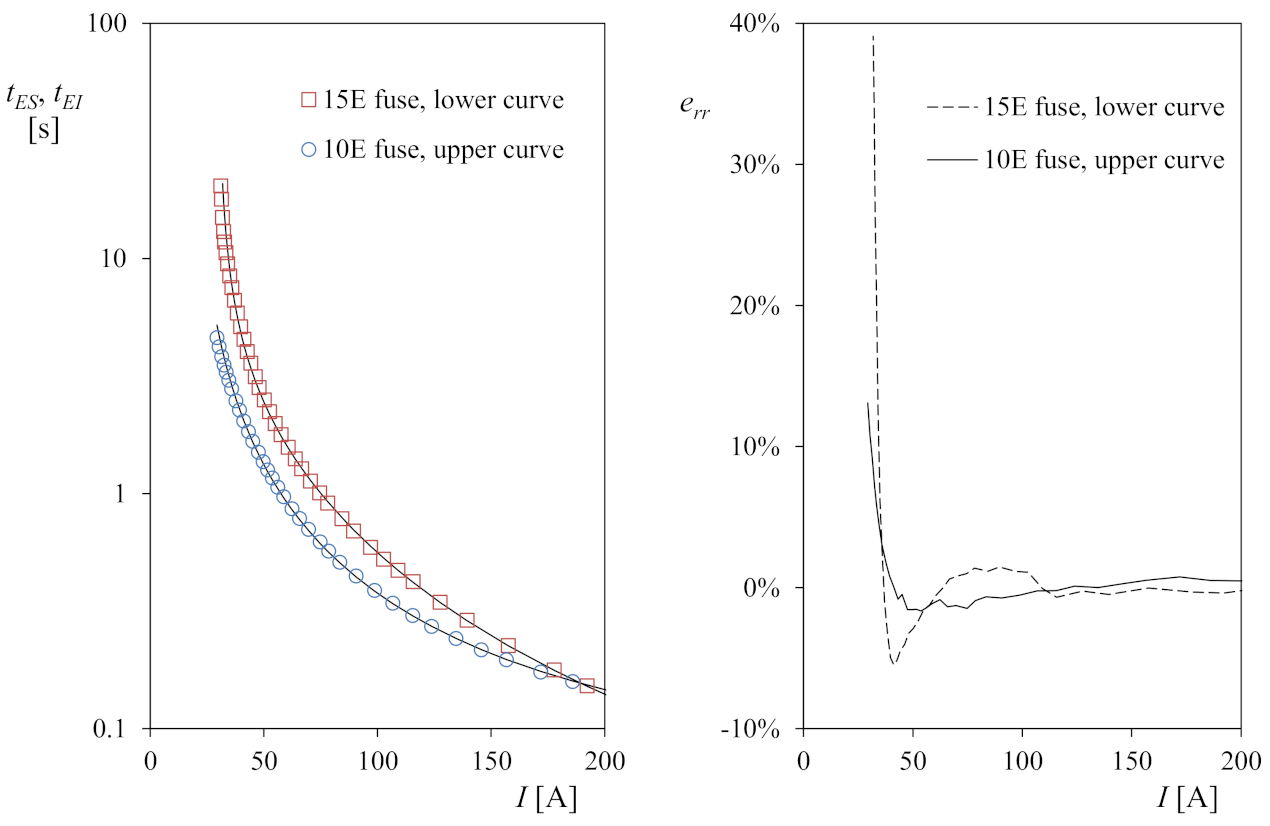
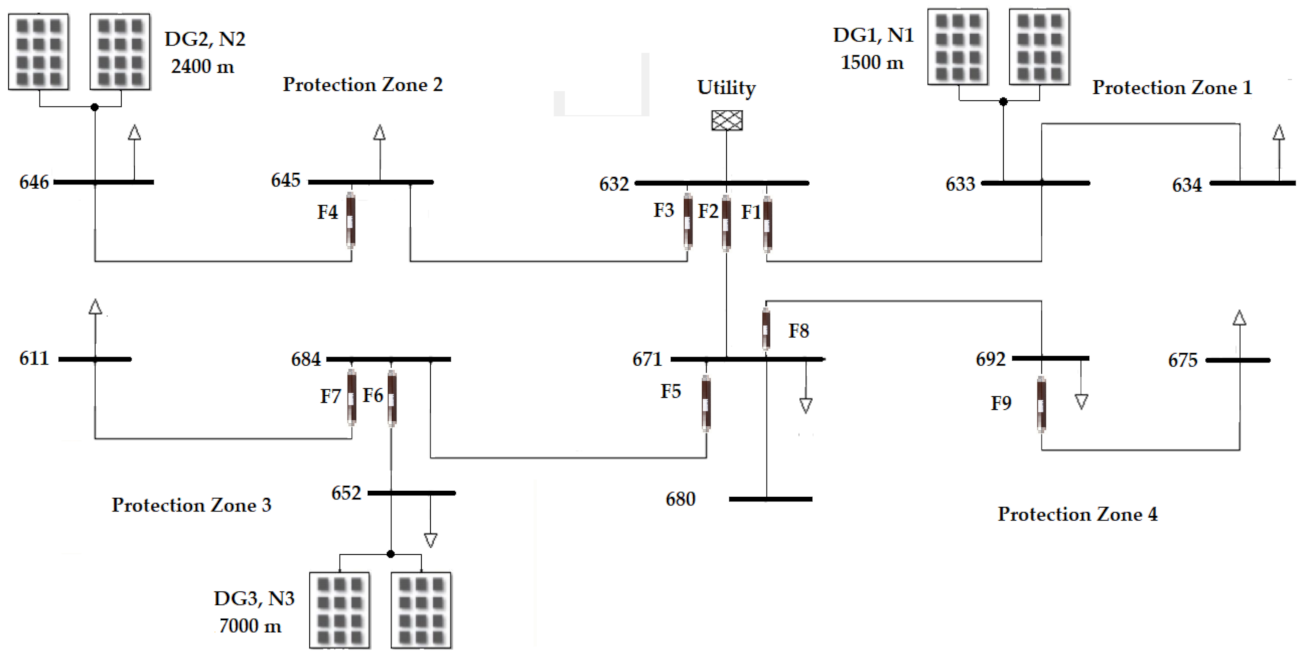
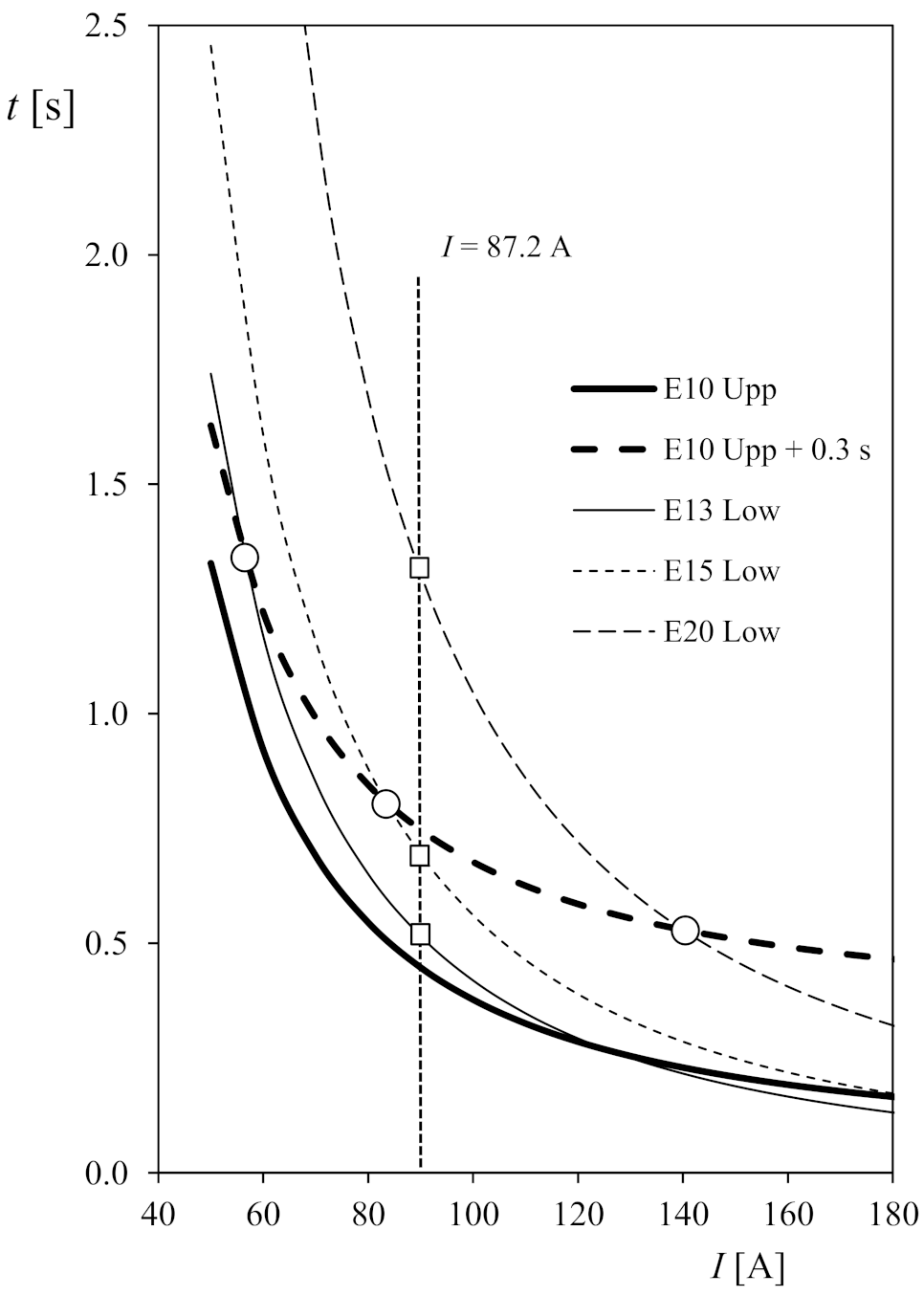

| Node | Distance (m) | Description |
|---|---|---|
| Node 633 (N1) | 1500 | Close to SE |
| Node 646 (N2) | 2400 | Moderate distance to SE |
| Node 652 (N3) | 7000 | Far from SE |
| Electrical resistance at 20 °C [Ω·km−1] | 0.614 |
| Electrical reactance at 20 °C [Ω·km−1] | 0.41 |
| Max. constant current [kA] | 0.202 |
| Location | Type | Power [MW] |
|---|---|---|
| Node 634 | Type Y | 1.5 |
| Node 611 | Type Y | 0.056 |
| Node 645 | Type Y | 0.056 |
| Node 646 | Type D | 0.5 |
| Node 652 | Type Y | 1 |
| Node 671 | Type D | 0.385 |
| Node 675 | Type Y | 0.281 |
| Node 692 | Type D | 0.056 |
| Fuse | I [A] | Fuse Selected |
|---|---|---|
| F1 | 53.75 | S&C SMD-50 30E |
| F2 | 62.5 | S&C SMD-50 40E |
| F3 | 20 | S&C SMD-50 13E |
| F4 | 17.5 | S&C SMD-50 10E |
| F5 | IF2 > 37.5 ≥ IF6+ IF7 | S&C SMD-50 30E |
| F6 | 35 | S&C SMD-50 20E |
| F7 | 2.5 | S&C SMD-50 5E |
| F8 | IF2 > 12.5≥ IF9 | S&C SMD-50 10E |
| F9 | 10 | S&C SMD-50 7E |
| Fuse | Curve | β0 [s−1] | β1 [s−1·A0.5] | β2 [s−1·A1] | β3 [s−1·A1.5] | β4 [s−1·A2] | β5 [s−1·A2.5] |
|---|---|---|---|---|---|---|---|
| 5E | upp; I < 299 A | −1.87460 | 1.3974 | −4.58631 × 10−1 | 7.76704 × 10−2 | −4.78102 × 10−3 | 9.97543 × 10−5 |
| upp; I > 299 A | 6.83807 | 3.61221 × 10−1 | 1.58040 × 10−3 | - | - | - | |
| low | −3.69555 | 2.55339 | −6.63554 × 10−1 | 8.13467 × 10−2 | −3.23895 × 10−3 | 1.03372 × 10−4 | |
| 7E | upp; I < 430 A | −1.51111 | 9.79975 × 10−1 | −2.84227 × 10−1 | 4.17970 × 10−2 | −2.15210 × 10−3 | 3.72960 × 10−5 |
| upp; I > 430 A | 5.82341 | 3.86086 × 10−1 | 1.42370 × 10−3 | - | - | - | |
| low | −8.63283 × 10−1 | 3.42341 × 10−1 | −4.85652 × 10−2 | 3.13876 × 10−3 | 6.24309 × 10−4 | 9.06465 × 10−7 | |
| 10E | upp; I < 558 A | −1.19851 | 7.03361 × 10−1 | −1.91430 × 10−1 | 2.59919 × 10−2 | −1.18321 × 10−3 | 1.79907 × 10−5 |
| upp; I > 558 A | 5.09321 | 3.95777 × 10−1 | 1.40653 × 10−3 | - | - | - | |
| low | −2.25987 × 10−1 | −7.04764 × 10−2 | 3.90330 × 10−2 | −5.07612 × 10−3 | 6.52842 × 10−4 | −4.82039 × 10−6 | |
| 13E | upp; I < 722 A | −1.78824 | 8.59426 × 10−1 | −1.82664 × 10−1 | 1.98489 × 10−2 | −7.64613 × 10−4 | 9.99949 × 10−6 |
| upp; I > 722 A | 3.78076 | 4.24034 × 10−1 | 1.25333 × 10−3 | - | - | - | |
| low | −5.38095 × 10−1 | 5.39468 × 10−2 | 1.66285 × 10−2 | −2.91772 × 10−3 | 3.92933 × 10−4 | −2.89251 × 10−6 | |
| 15E | upp; I < 826 A | −1.90389 | 8.37374 × 10−1 | −1.64212 × 10−1 | 1.64897 × 10−2 | −5.90620 × 10−4 | 7.21544 × 10−6 |
| upp; I > 826 A | 3.78076 | 4.24034 × 10−1 | 1.25333 × 10−3 | - | - | - | |
| low | −2.93095 | 1.17318 | −1.84165 × 10−1 | 1.40294 × 10−2 | −3.33170 × 10−4 | 6.99420 × 10−6 | |
| 20E | upp; I < 1138 | −1.69113 | 6.44722 × 10−1 | −1.09999 × 10−1 | 9.57500 × 10−3 | −2.88718 × 10−4 | 2.96029 × 10−6 |
| upp; I > 1138 | 6.64811 × 10−1 | 4.79303 × 10−1 | 9.81018 × 10−4 | - | - | - | |
| low | −1.55131 | 4.65904 × 10−1 | −5.60123 × 10−2 | 3.39124 × 10−3 | −4.81103 × 10−6 | 1.06292 × 10−6 | |
| 25E | upp; I < 1458 | −2.40136 | 7.94736 × 10−1 | −1.10811 × 10−1 | 7.81405 × 10−3 | −2.01186 × 10−4 | 1.79140 × 10−6 |
| upp; I > 1458 | −1.97454 | 5.25978 × 10−1 | 7.36144 × 10−4 | - | - | - | |
| low | −2.86886 | 8.54336 × 10−01 | −9.67943 × 10−2 | 5.21690 × 10−3 | −7.42881 × 10−5 | 1.23231 × 10−6 | |
| 30E | upp; I < 1608 A | −2.18019 | 6.71422 × 10−1 | −9.07023 × 10−2 | 6.20992 × 10−3 | −1.51163 × 10−4 | 1.26547 × 10−6 |
| upp; I > 1608 A | −2.64464 | 5.27075 × 10−1 | 7.90099 × 10−4 | - | - | - | |
| low | −1.27531 | 2.68551 × 10−1 | −2.21904 × 10−2 | 9.05809 × 10−4 | 2.87958 × 10−5 | 1.36786 × 10−7 | |
| 40E | upp; I < 2065 A | −1.56502 | 4.32637 × 10−1 | −5.62540 × 10−2 | 3.66028 × 10−3 | −7.87726 × 10−5 | 5.76520 × 10−7 |
| upp; I > 2065 A | −6.65936 | 5.92598 × 10−1 | 4.68242 × 10−4 | - | - | - | |
| low | −1.83832 × 10−2 | −1.07938 × 10−1 | 1.62356 × 10−2 | −8.70876 × 10−4 | 4.91068 × 10−5 | −1.84714 × 10−7 | |
| 50E | upp; I < 2517 A | −2.63857 | 6.27277 × 10−1 | −6.44707 × 10−2 | 3.34754 × 10−3 | −6.24271 × 10−5 | 4.05220 × 10−7 |
| upp; I > 2517 A | −8.97351 | 6.01037 × 10−1 | 5.73675 × 10−4 | - | - | - | |
| low | −2.28308 | 4.41665 × 10−1 | −3.36337 × 10−2 | 1.24261 × 10−3 | −2.86096 × 10−6 | 1.46350 × 10−7 | |
| 65E | upp; I < 3397 A | −2.02202 | 4.32137 × 10−1 | −4.03342 × 10−2 | 1.85871 × 10−3 | −2.89685 × 10−5 | 1.55962 × 10−7 |
| upp; I > 3397 A | −1.68545 × 10+1 | 7.07076 × 10−1 | 1.20284 × 10−4 | - | - | - | |
| low | −6.28233 × 10−1 | 5.43519 × 10−2 | −1.10800 × 10−3 | −3.06980 × 10−5 | 1.19222 × 10−5 | −1.96977 × 10−8 |
| DG | Case | DG Distribution | Status Result | ||
|---|---|---|---|---|---|
| Bus 633 | Bus 646 | Bus 652 | |||
| 25% | 1 | - | - | 25% | OK |
| 2 | - | 25% | - | OK | |
| 3 | 25% | - | - | OK | |
| 50% | 4 | - | - | 50% | OK |
| 5 | - | 25% | 25% | F3, F4 | |
| 6 | - | 50% | - | F3, F4 | |
| 7 | 25% | - | 25% | OK | |
| 8 | 25% | 25% | - | F4 | |
| 9 | 50% | - | - | OK | |
| 75% | 10 | - | - | 75% | F6 |
| 11 | - | 25% | 50% | OK | |
| 12 | - | 50% | 25% | F3, F4, F6 | |
| 13 | - | 75% | - | F3, F4 | |
| 14 | 25% | - | 50% | OK | |
| 15 | 25% | 25% | 25% | F3, F4 | |
| 16 | 25% | 50% | - | F3, F4 | |
| 17 | 50% | - | 25% | OK | |
| 18 | 50% | 25% | - | OK | |
| 19 | 75% | - | - | OK | |
| 100% | 20 | - | - | 100% | F5, F6 |
| 21 | - | 25% | 75% | F5, F6 | |
| 22 | - | 50% | 50% | F4 | |
| 23 | - | 75% | 25% | F3, F4, F6 | |
| 24 | - | 100% | - | F4 | |
| 25 | 25% | - | 75% | F6 | |
| 26 | 25% | 25% | 50% | F4 | |
| 27 | 25% | 50% | 25% | F4 | |
| 28 | 25% | 75% | - | F4 | |
| 29 | 50% | - | 50% | OK | |
| 30 | 50% | 25% | 25% | F4 | |
| 31 | 50% | 50% | - | F4 | |
| 32 | 75% | - | 25% | OK | |
| 33 | 75% | 25% | - | OK | |
| 34 | 100% | - | - | F1 | |
| DG | Case | DG Distribution | Result | ||
|---|---|---|---|---|---|
| Bus 633 | Bus 646 | Bus 652 | |||
| 25% | 1 | - | - | 25% | OK |
| 2 | - | 25% | - | OK | |
| 3 | 25% | - | - | OK | |
| 50% | 4 | - | - | 50% | OK |
| 5 | - | 25% | 25% | OK (*) | |
| 6 | - | 50% | - | F3, F4 | |
| 7 | 25% | - | 25% | OK | |
| 8 | 25% | 25% | - | OK (*) | |
| 9 | 50% | - | - | OK | |
| 75% | 10 | - | - | 75% | F6 |
| 11 | - | 25% | 50% | OK | |
| 12 | - | 50% | 25% | F3, F4 | |
| 13 | - | 75% | - | F3, F4 | |
| 14 | 25% | - | 50% | OK | |
| 15 | 25% | 25% | 25% | OK (*) | |
| 16 | 25% | 50% | - | F3, F4 | |
| 17 | 50% | - | 25% | OK | |
| 18 | 50% | 25% | - | OK | |
| 19 | 75% | - | - | OK | |
| 100% | 20 | - | - | 100% | F5, F6 |
| 21 | - | 25% | 75% | F6 | |
| 22 | - | 50% | 50% | F4 | |
| 23 | - | 75% | 25% | F3, F4 | |
| 24 | - | 100% | - | F3, F4 | |
| 25 | 25% | - | 75% | F6 | |
| 26 | 25% | 25% | 50% | OK (*) | |
| 27 | 25% | 50% | 25% | F3, F4 | |
| 28 | 25% | 75% | - | OK | |
| 29 | 50% | - | 50% | OK | |
| 30 | 50% | 25% | 25% | OK | |
| 31 | 50% | 50% | - | F3, F4 | |
| 32 | 75% | - | 25% | OK | |
| 33 | 75% | 25% | - | OK | |
| 34 | 100% | - | - | F1 | |
| Case | Zone 1 | Zone 2 | Zone 3 | CTI [s] | Status Result | |||
|---|---|---|---|---|---|---|---|---|
| tF1 [s] | tF3 [s] | tF4 [s] | tF2 [s] | tF5 [s] | tF6 [s] | CTI > 0.3 s | ||
| 5 | - | 7.84 | 3.48 | - | - | - | 4.36 | OK |
| 6 | - | 3.16 | 1.61 | - | - | - | 1.55 | OK |
| 12 | - | 1.37 | 0.75 | - | - | 3.11 | 0.62 | OK |
| 13 | - | 0.94 | 0.52 | - | - | - | 0.42 | OK |
| 15 | - | 5.01 | 2.55 | - | - | - | 2.46 | OK |
| 16 | - | 1.16 | 0.65 | - | - | 0.51 | OK | |
| 20 | - | - | - | - | 4.16 | 1.43 | 2.73 | OK |
| 21 | - | 5.45 | 2.73 | - | 29.58 | 2.84 | 2.72 | OK |
| 23 | - | 0.56 | 0.47 | - | - | 6.16 | 0.09 | Not OK |
| Case | Zone 1 | Zone 2 | Zone 3 | CTI [s] | Status Result | |||
|---|---|---|---|---|---|---|---|---|
| tF1 [s] | tF3 [s] | tF4 [s] | tF2 [s] | tF5 [s] | tF6 [s] | CTI > 0.3 s | ||
| 6 | - | 3.27 | 1.67 | - | - | - | 1.60 | OK |
| 12 | - | 3.29 | 1.67 | - | - | - | 1.62 | OK |
| 13 | - | 1.00 | 0.55 | - | - | - | 0.45 | OK |
| 16 | - | 3.28 | 1.67 | - | - | - | 1.67 | OK |
| 20 | - | - | 6.24 | 1.78 | 4.46 | OK | ||
| 23 | - | 1.00 | 0.55 | - | - | - | 0.45 | OK |
| 24 | - | 0.49 | 0.42 | - | - | - | 0.07 | Not OK |
| 27 | - | 3.30 | 1.68 | - | - | - | 1.62 | OK |
| 28 | - | 1.00 | 0.55 | - | - | - | 0.45 | OK |
| 31 | - | 3.29 | 1.68 | - | - | - | 1.61 | OK |
Publisher’s Note: MDPI stays neutral with regard to jurisdictional claims in published maps and institutional affiliations. |
© 2021 by the authors. Licensee MDPI, Basel, Switzerland. This article is an open access article distributed under the terms and conditions of the Creative Commons Attribution (CC BY) license (http://creativecommons.org/licenses/by/4.0/).
Share and Cite
Pindado, S.; Alcala-Gonzalez, D.; Alfonso-Corcuera, D.; García del Toro, E.M.; Más-López, M.I. Improving the Power Supply Performance in Rural Smart Grids with Photovoltaic DG by Optimizing Fuse Selection. Agronomy 2021, 11, 622. https://doi.org/10.3390/agronomy11040622
Pindado S, Alcala-Gonzalez D, Alfonso-Corcuera D, García del Toro EM, Más-López MI. Improving the Power Supply Performance in Rural Smart Grids with Photovoltaic DG by Optimizing Fuse Selection. Agronomy. 2021; 11(4):622. https://doi.org/10.3390/agronomy11040622
Chicago/Turabian StylePindado, Santiago, Daniel Alcala-Gonzalez, Daniel Alfonso-Corcuera, Eva M. García del Toro, and María Isabel Más-López. 2021. "Improving the Power Supply Performance in Rural Smart Grids with Photovoltaic DG by Optimizing Fuse Selection" Agronomy 11, no. 4: 622. https://doi.org/10.3390/agronomy11040622
APA StylePindado, S., Alcala-Gonzalez, D., Alfonso-Corcuera, D., García del Toro, E. M., & Más-López, M. I. (2021). Improving the Power Supply Performance in Rural Smart Grids with Photovoltaic DG by Optimizing Fuse Selection. Agronomy, 11(4), 622. https://doi.org/10.3390/agronomy11040622







